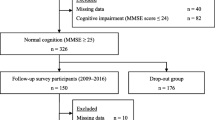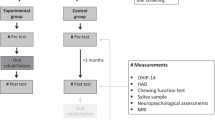Abstract
Previous studies have reported an association between tooth loss and gray matter volume (GMV) in healthy adults. The study aims to elucidate the link between tooth loss, brain volume differences, and cognitive impairment by investigating the total and regional differences in GMV associated with tooth loss in older people with and without cognitive impairment. Forty older participants with mild cognitive impairment or Alzheimer’s disease [the cognitive impairment (CI) group] and 30 age- and sex-matched healthy participants [the control (CON) group] received T1-weighted magnetic resonance imaging scans and assessments of oral functions, including masticatory performance (MP) and the number of missing teeth (NMT). Voxel-based morphometry was used to assess the total and regional GMV, including that of the medial temporal lobe and motor-related areas. (A) When the total intracranial volume and age were controlled for, an increased MP was associated with a larger GMV in the premotor cortex in the CON group. (B) In the CI group, an increased NMT was significantly correlated with smaller regional GMV of the bilateral primary motor cortex and the premotor cortex. (C) In the CI group, but not the CON group, an increased NMT was associated with both smaller total GMV and regional GMV of the left medial temporal lobe, including the left hippocampus and parahippocampus. Tooth loss may be preferentially related to the structural differences in the medial temporal lobe in cognitively impaired older people. Further research is required to understand the mechanisms of the relationships.


Similar content being viewed by others
References
Aisen, P. S., Cummings, J., Jack Jr., C. R., Morris, J. C., Sperling, R., Frolich, L., Jones, R. W., Dowsett, S. A., Matthews, B. R., Raskin, J., Scheltens, P., & Dubois, B. (2017). On the path to 2025: Understanding the Alzheimer's disease continuum. Alzheimer's Research & Therapy, 9(1), 60. https://doi.org/10.1186/s13195-017-0283-5.
Ashburner, J. (2007). A fast diffeomorphic image registration algorithm. Neuroimage, 38(1), 95–113. https://doi.org/10.1016/j.neuroimage.2007.07.007.
Avivi-Arber, L., Seltzer, Z., Friedel, M., Lerch, J. P., Moayedi, M., Davis, K. D., & Sessle, B. J. (2017). Widespread volumetric brain changes following tooth loss in female mice. Frontiers in Neuroanatomy, 10, 121. https://doi.org/10.3389/fnana.2016.00121.
Barnes, J., Ridgway, G. R., Bartlett, J., Henley, S. M., Lehmann, M., Hobbs, N., Clarkson, M. J., MacManus, D. G., Ourselin, S., & Fox, N. C. (2010). Head size, age and gender adjustment in MRI studies: A necessary nuisance? Neuroimage, 53(4), 1244–1255. https://doi.org/10.1016/j.neuroimage.2010.06.025.
Cerutti-Kopplin, D., Feine, J., Padilha, D. M., de Souza, R. F., Ahmadi, M., Rompre, P., Booji, L., & Emami, E. (2016). Tooth loss increases the risk of diminished cognitive function: A systematic review and meta-analysis. JDR Clinical & Translational Research.
Chen, H., Iinuma, M., Onozuka, M., & Kubo, K. Y. (2015). Chewing maintains Hippocampus-dependent cognitive function. International Journal of Medical Sciences, 12(6), 502–509. https://doi.org/10.7150/ijms.11911.
Diedrichsen, J., & Kornysheva, K. (2015). Motor skill learning between selection and execution. Trends in Cognitive Sciences, 19(4), 227–233. https://doi.org/10.1016/j.tics.2015.02.003.
Dintica, C. S., Rizzuto, D., Marseglia, A., Kalpouzos, G., Welmer, A. K., Wardh, I., Backman, L., & Xu, W. (2018). Tooth loss is associated with accelerated cognitive decline and volumetric brain differences: A population-based study. Neurobiology of Aging, 67, 23–30. https://doi.org/10.1016/j.neurobiolaging.2018.03.003.
Foley, N. C., Affoo, R. H., Siqueira, W. L., & Martin, R. E. (2017). A systematic review examining the Oral health status of persons with dementia. JDR Clin Trans Res, 2(4), 330–342. https://doi.org/10.1177/2380084417714789.
Folstein, M. F., Folstein, S. E., & McHugh, P. R. (1975). "mini-mental state". A practical method for grading the cognitive state of patients for the clinician. Journal of Psychiatric Research, 12(3), 189–198 http://www.ncbi.nlm.nih.gov/pubmed/1202204.
Guigoz, Y., Vellas, B., & Garry, P. J. (1996). Assessing the nutritional status of the elderly: The mini nutritional assessment as part of the geriatric evaluation. Nutrition Reviews, 54(1 Pt 2), S59–S65 http://www.ncbi.nlm.nih.gov/pubmed/8919685.
Hama, Y., Kanazawa, M., Minakuchi, S., Uchida, T., & Sasaki, Y. (2014). Reliability and validity of a quantitative color scale to evaluate masticatory performance using color-changeable chewing gum. Journal of Medical and Dental Sciences, 61(1), 1–6 http://www.ncbi.nlm.nih.gov/pubmed/24658959.
Hamalainen, A., Tervo, S., Grau-Olivares, M., Niskanen, E., Pennanen, C., Huuskonen, J., Kivipelto, M., Hanninen, T., Tapiola, M., Vanhanen, M., Hallikainen, M., Helkala, E. L., Nissinen, A., Vanninen, R., & Soininen, H. (2007). Voxel-based morphometry to detect brain atrophy in progressive mild cognitive impairment. Neuroimage, 37(4), 1122–1131. https://doi.org/10.1016/j.neuroimage.2007.06.016.
Hayakawa, I., Watanabe, I., Hirano, S., Nagao, M., & Seki, T. (1998). A simple method for evaluating masticatory performance using a color-changeable chewing gum. The International Journal of Prosthodontics, 11(2), 173–176 http://www.ncbi.nlm.nih.gov/pubmed/9709608.
Holmer, J., Eriksdotter, M., Schultzberg, M., Pussinen, P. J., & Buhlin, K. (2018). Association between periodontitis and risk of Alzheimer's disease, mild cognitive impairment and subjective cognitive decline: A case-control study. Journal of Clinical Periodontology, 45(11), 1287–1298. https://doi.org/10.1111/jcpe.13016.
Ikebe, K., Matsuda, K., Kagawa, R., Enoki, K., Okada, T., Yoshida, M., & Maeda, Y. (2012). Masticatory performance in older subjects with varying degrees of tooth loss. Journal of Dentistry, 40(1), 71–76. https://doi.org/10.1016/j.jdent.2011.10.007.
Karas, G. B., Scheltens, P., Rombouts, S. A., Visser, P. J., van Schijndel, R. A., Fox, N. C., & Barkhof, F. (2004). Global and local gray matter loss in mild cognitive impairment and Alzheimer's disease. Neuroimage, 23(2), 708–716. https://doi.org/10.1016/j.neuroimage.2004.07.006.
Kobayashi, T., Kubota, M., Takahashi, T., Nakasato, A., Nomura, T., Furuya, J., & Kondo, H. (2018). Effects of tooth loss on brain structure: A voxel-based morphometry study. Journal of Prosthodontic Research, 62(3), 337–341. https://doi.org/10.1016/j.jpor.2017.12.007.
Lin, C. S. (2018a). Meta-analysis of brain mechanisms of chewing and clenching movements. Journal of Oral Rehabilitation, 45(8), 627–639. https://doi.org/10.1111/joor.12657.
Lin, C. S. (2018b). Revisiting the link between cognitive decline and masticatory dysfunction. BMC Geriatrics, 18(1), 5. https://doi.org/10.1186/s12877-017-0693-z.
Lin, K. N., Wang, P. N., Liu, C. Y., Chen, W. T., Lee, Y. C., & Liu, H. C. (2002). Cutoff scores of the cognitive abilities screening instrument, Chinese version in screening of dementia. Dementia and Geriatric Cognitive Disorders, 14(4), 176–182. https://doi.org/10.1159/000066024.
Lin, C. S., Wu, S. Y., Wu, C. Y., & Ko, H. W. (2015). Gray matter volume and resting-state functional connectivity of the motor cortex-cerebellum network reflect the individual variation in masticatory performance in healthy elderly people. Frontiers in Aging Neuroscience, 7, 247. https://doi.org/10.3389/fnagi.2015.00247.
Lin, C. S., Wu, C. Y., Wu, S. Y., Chuang, K. H., Lin, H. H., Cheng, D. H., & Lo, W. L. (2017). Age- and sex-related differences in masseter size and its role in oral functions. Journal of the American Dental Association (1939), 148(9), 644–653. https://doi.org/10.1016/j.adaj.2017.03.001.
McKhann, G. M., Knopman, D. S., Chertkow, H., Hyman, B. T., Jack Jr., C. R., Kawas, C. H., Klunk, W. E., Koroshetz, W. J., Manly, J. J., Mayeux, R., Mohs, R. C., Morris, J. C., Rossor, M. N., Scheltens, P., Carrillo, M. C., Thies, B., Weintraub, S., & Phelps, C. H. (2011). The diagnosis of dementia due to Alzheimer's disease: Recommendations from the National Institute on Aging-Alzheimer's Association workgroups on diagnostic guidelines for Alzheimer's disease. Alzheimers Dement, 7(3), 263–269. https://doi.org/10.1016/j.jalz.2011.03.005.
Neiheisel, J. R. (2018). Sobel test. In M. Allen (Ed.), The SAGE encyclopedia of communication research methods (pp. 1617–1618). Thousand Oaks: SAGE Publications, Inc.
Pennanen, C., Testa, C., Laakso, M. P., Hallikainen, M., Helkala, E. L., Hanninen, T., Kivipelto, M., Kononen, M., Nissinen, A., Tervo, S., Vanhanen, M., Vanninen, R., Frisoni, G. B., & Soininen, H. (2005). A voxel based morphometry study on mild cognitive impairment. Journal of Neurology, Neurosurgery, and Psychiatry, 76(1), 11–14. https://doi.org/10.1136/jnnp.2004.035600.
Poldrack, R. A. (2007). Region of interest analysis for fMRI. Social Cognitive and Affective Neuroscience, 2(1), 67–70. https://doi.org/10.1093/scan/nsm006.
Schimmel, M., Christou, P., Herrmann, F., & Muller, F. (2007). A two-colour chewing gum test for masticatory efficiency: Development of different assessment methods [research support, Non-U.S. Gov't. Validation Studies]. J Oral Rehabil, 34(9), 671–678. https://doi.org/10.1111/j.1365-2842.2007.01773.x
Schneider, C. A., Rasband, W. S., & Eliceiri, K. W. (2012). NIH image to ImageJ: 25 years of image analysis. Nature Methods, 9(7), 671–675 http://www.ncbi.nlm.nih.gov/pubmed/22930834.
Seidler, R. D., Bernard, J. A., Burutolu, T. B., Fling, B. W., Gordon, M. T., Gwin, J. T., Kwak, Y., & Lipps, D. B. (2010). Motor control and aging: Links to age-related brain structural, functional, and biochemical effects. Neuroscience and Biobehavioral Reviews, 34(5), 721–733. https://doi.org/10.1016/j.neubiorev.2009.10.005.
Stein, P. S., Desrosiers, M., Donegan, S. J., Yepes, J. F., & Kryscio, R. J. (2007). Tooth loss, dementia and neuropathology in the Nun study. Journal of the American Dental Association (1939), 138(10), 1314–1322 quiz 1381-1312. http://www.ncbi.nlm.nih.gov/pubmed/17908844.
Tada, A., & Miura, H. (2017). Association between mastication and cognitive status: A systematic review. Archives of Gerontology and Geriatrics, 70, 44–53. https://doi.org/10.1016/j.archger.2016.12.006.
Takeuchi, K., Izumi, M., Furuta, M., Takeshita, T., Shibata, Y., Kageyama, S., Ganaha, S., & Yamashita, Y. (2015). Posterior teeth occlusion associated with cognitive function in nursing home older residents: A cross-sectional observational study. PLoS One, 10(10), e0141737. https://doi.org/10.1371/journal.pone.0141737.
Teng, E. L., Hasegawa, K., Homma, A., Imai, Y., Larson, E., Graves, A., Sugimoto, K., Yamaguchi, T., Sasaki, H., Chiu, D., et al. (1994). The cognitive abilities screening instrument (CASI): A practical test for cross-cultural epidemiological studies of dementia [comparative study]. International Psychogeriatrics, 6(1), 45–58 discussion 62. http://www.ncbi.nlm.nih.gov/pubmed/8054493.
Ueno, M., Yanagisawa, T., Shinada, K., Ohara, S., & Kawaguchi, Y. (2010). Category of functional tooth units in relation to the number of teeth and masticatory ability in Japanese adults. Clinical Oral Investigations, 14(1), 113–119. https://doi.org/10.1007/s00784-009-0270-8.
Wang, W. Y., Yu, J. T., Liu, Y., Yin, R. H., Wang, H. F., Wang, J., Tan, L., Radua, J., & Tan, L. (2015). Voxel-based meta-analysis of grey matter changes in Alzheimer's disease. Transl Neurodegener, 4, 6. https://doi.org/10.1186/s40035-015-0027-z.
Weijenberg, R. A., Scherder, E. J., & Lobbezoo, F. (2011). Mastication for the mind--the relationship between mastication and cognition in ageing and dementia. Neuroscience and Biobehavioral Reviews, 35(3), 483–497. https://doi.org/10.1016/j.neubiorev.2010.06.002.
Winblad, B., Palmer, K., Kivipelto, M., Jelic, V., Fratiglioni, L., Wahlund, L. O., Nordberg, A., Backman, L., Albert, M., Almkvist, O., Arai, H., Basun, H., Blennow, K., de Leon, M., DeCarli, C., Erkinjuntti, T., Giacobini, E., Graff, C., Hardy, J., Jack, C., Jorm, A., Ritchie, K., van Duijn, C., Visser, P., & Petersen, R. C. (2004). Mild cognitive impairment--beyond controversies, towards a consensus: Report of the international working group on mild cognitive impairment. Journal of Internal Medicine, 256(3), 240–246. https://doi.org/10.1111/j.1365-2796.2004.01380.x.
Acknowledgements
This work was supported in part by the 3 T MRI Core Facility at National Yang-Ming University.
Funding
C-S Lin was funded by the Ministry of Science and Technology of Taiwan (MOST 103–2314-B-010-025-MY3 and MOST 105–2628-B-010-008-MY4). S-J Wang was funded by Academia Sinica of Taiwan (AS-BD-108-2). J-L Fuh was funded by the Ministry of Science and Technology of Taiwan (106–2321-B-075-001, 107–2221-E075–006), Taipei Veterans General Hospital (V107C-032, V108C-113, V109C-061, VGHUST109-V1–5-1), the Brain Research Center, National Yang-Ming University from The Featured Areas Research Center Program within the framework of the Higher Education Sprout Project by the Ministry of Education (MOE) in Taiwan. This work was supported in part by the 3 T MRI Core Facility at National Yang-Ming University.
Author information
Authors and Affiliations
Contributions
C-S Lin designed the study, performed the experiments, analyzed the data, and wrote the manuscript. H-H Lin performed the experiments. C-S Lin, S-W Fann, W-J Lee, M-L Hsu, S-J Wang, and J-L Fuh designed the study. C-S Lin, S-J Wang and J-L Fuh wrote the manuscript. All authors read and approved the final version of the manuscript.
Corresponding authors
Ethics declarations
Conflict of interest
All the authors have no conflicts of interest to disclose.
Research involving human participants and/or animals
All procedures performed in the study were in accordance with the ethical standards of the 1964 Helsinki declaration.
Informed consent
All the participants have given written informed consent (IRB code number: YM104028E, issued and supervised by the Internal Review Board of National Yang-Ming University and IRB code number: 2012–05-033B, issued and supervised by the Taipei Veterans General Hospital) before the experiment initiated.
Additional information
Publisher’s note
Springer Nature remains neutral with regard to jurisdictional claims in published maps and institutional affiliations.
Rights and permissions
About this article
Cite this article
Lin, CS., Lin, HH., Fann, SW. et al. Association between tooth loss and gray matter volume in cognitive impairment. Brain Imaging and Behavior 14, 396–407 (2020). https://doi.org/10.1007/s11682-020-00267-w
Published:
Issue Date:
DOI: https://doi.org/10.1007/s11682-020-00267-w




